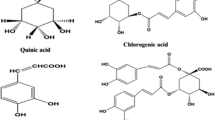Summary
The influence of the two commonly used spices Murraya koenigii (curry leaf) leaf and Brassica juncea (mustard) seeds on the levels of lipids, fecal bile acids and neutral sterols was studied in rats administered 1,2-dimethyl hydrazine (1,2 DMH). The levels of cholesterol and phospholipids decreased in the experimental groups when compared with the control. The cholesterol phospholipid ratio showed an elevated level in the DMH treated control compared with the spices group. Bile acids and neutral sterols showed a sharp increase in the spices treated groups in liver and feces when compared with the control. Morphological and histological studies revealed that the mean number of neoplasms in the colon and intestine were significantly low in the spices fed groups.
Similar content being viewed by others
References
Chitra S, Sabitha K, Nalini N, Menon VP: Influence of red chilli on lipids and bile acids in different tissues in experimental colon cancer. Ind J Exp Biol 32:793–796, 1994
Kuttan R, Soudamini KK, Unnikrishnan MC: Mutagenicity and antimutagenicity of some Indian spices. Amala Res Bull 9:38–42, 1989
Burt RW, Bishop DT, Lynch HT, Roxen P, Winawer S: Risk and surveillance of individuals with heritable factors for colorectal cancer. Bull WHO 68:655–665, 1990
Fujiyoshy T: An epidemiological study on relationship between life style and colorectal cancer. Jap J Cancer Clin 36(3):334–343, 1990
Toth B: Synthetic and naturally occurring hydrazines as possible cancer causative agents. Cancer Res 35:3693–3695, 1975
Raveendran CA: A clinical evaluation on hypercholesterinemia with special reference to kalasaka. University of Kerala, MD Thesis: 69–75, 1988
Folch J, Less M, Stanley GHS: A simple method for the isolation and purification of total lipids from animal tissues. J Biol Chem 226:497–509, 1957
Abell LL, Levy BB, Brodie BB, Kendel FF: A simplified method for the estimation of total cholesterol in serum and demonstration of its specificity. J Biol Chem 195:357–366, 1952
Zilversmit DB, Davis AK: Microdetermination of phospholipids. J Lab Clin Med 35:155, 1950
Grundy SM, Miettiner TA: Quantitative isolation and gas liquid Chromatographic analysis of total fecal bile acids. J Lipid Res 6:379–410, 1965
Snell FD, Snell CT: Estimation of bile acids in colorimetric methods of analysis, p 351. New York: Van Nostrand, 1965
Bennet CA, Franklin ML: In: Statistical Analysis in Chemistry and Chemical Industry, p 133, pp 105–108. New York: John Wiley, 1967
Petrovich DP, Waring AJ, Farbes JL: Liver ischemia increases the molecular order of microsomal membranes by increasing the cholesterol to phospholipid ratio. J Biol Chem 259:13217, 1984
Hostmark AT: Plasma lipids, lipoprotein and fecal excretion of neutral sterols and bile acids in rats fed various high fat diets or low fat/high sucrose diet. J Nutr 119:356–363, 1989
Marsch D, Knowles PF, Rattle HW: In: Magnetic Resonance of Biomolecules, p 237. New York: John Wiley, 1976
Srinivasan MR, Chandrasekhara N: The effects of spices on 7-α-hydroxylase activity and on cholesterol levels in the rat. Int J Vitam Nutr Res 61:364–369, 1992
Author information
Authors and Affiliations
Rights and permissions
About this article
Cite this article
Khan, B.A., Abraham, A. & Leelamma, S. Murraya koenigii and Brassica juncea — Alterations on lipid profile in 1–2 dimethyl hydrazine induced colon carcinogenesis. Invest New Drugs 14, 365–369 (1996). https://doi.org/10.1007/BF00180812
Issue Date:
DOI: https://doi.org/10.1007/BF00180812




